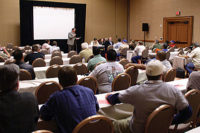
As part of the comprehensive seminar program at StonExpo East, which took place earlier this year in Atlanta, GA, a panel of industry veterans held an open “Countertop Installation Forum” with fabricators representing shops of all sizes from around the country. Panelists included Clark Jones of Brentwood Granite, Marble & Tile, LLC in Brentwood, TN; Lindell Lummer of Malibu Art Tile & Stone of Malibu, CA; and Duane Naquin of Stone Interiors in Gaston, SC. The following is a synopsis of the topics that were discussed during the forum:
What are people doing in terms of front and rear sink seams?
All three panelists agreed that it is not generally a good practice. “We avoid that whenever possible, especially with 2-cm material,” Lummer said.
“You can cut slots and stabilize it with a washer, but it’s really something you want to avoid,” said Naquin. “That’s where people are going to be working.”
Some of the fabricators in attendance argued that using seams at the sink cut-out would help avoid breakage (because the overall length of the workpiece would be smaller) and also utilize smaller seams, but the panelists reiterated that the practice should generally be avoided, especially with more complex sinks.
Members of the audience also asked about a “mini seam setter” that would be able to work with smaller-sized seams, but the smallest seam clamps noted were 6 inches. When a seam is required in these smaller areas, the panel suggested placing a block of stone over the seam and clamping it to ensure it is level.
What is optimal seam placement?
Naquin opened the discussion on this topic by explaining that sometimes seam placement is dependent upon the machinery at work in the shop. Fabricators that are equipped with a CNC stoneworking center can let the stone turn the corner before cutting the seam, while shops using a line polisher will be more likely to place the seams in the corner.
Naquin went on to explain that “seams are something to be sold” to the homeowners, and they need to be discussed from the beginning. “You need to establish with the customer where the seams should be up front.”
From a practical standpoint, Jones said that it is best to locate the seams over supporting parts of the cabinetry.
What size limits are fabricators establishing for countertop parts?
Naquin said his company has a written policy in place where it will not do undermount sinks in pieces over 80 inches long. “We will make exceptions, but too much is a risk and a potential liability,” he said. “Our installation crews are two people, and we have a $250 ‘large piece charge’ for anything more than 300 pounds. Otherwise, a seam is placed.”
Adding to this thought, Lummer said his company charges an extra $10 per square foot for islands because of the extra manpower required.
“We have even had upcharges for the use of the crane,” Jones said. “Do not accept liability without pay. You need to figure out your costs of adding labor and equipment, and recoup those costs from the customer.”
How many fabricators are top polishing their seams after installation? What is the value? Is it profitable?
Response to this issue was divided. While none of the panelists said they are top polishing their seams, some of the fabricators in the audience said they were making this step part of their overall installation process.
“[Top polishing] shouldn’t be needed if your installers are good,” said Naquin. “We do 120 kitchens per week, and we’ve never had to surface polish. If it’s something you really want to do, I’d suggest testing it out in the shop on a practice piece, because if the homeowner doesn’t like it, you may end up replacing the job. I really think it is more of a problem resolution for bowed pieces or other issues with uneven seams rather than something that needs to be in regular practice.”
One of the fabricators in the audience said his company began top polishing all jobs as a value added service, and he has been able to sell customers on the increase in quality. “We get a tight 1/32-inch seam, and you cannot feel it at all,” he said. “We have lots of low-ball competitors in our area, and this sets us apart.” The fabricator went on to say that he doesn’t break out “seam polishing” as a specific charge, but it helps justify a higher cost than some competitors. “It is valuable to show contractors one factor that allows us to charge a higher price.”
Continuing his thoughts on top polishing, the fabricator in the audience said that workers learn the process in the shop before moving into the field. “It only takes 15 to 30 minutes, and people have to prove themselves in the shop using wet pads. We have them start with Black Galaxy, because if they can do Black Galaxy, they can do anything.”
What are fabricators doing when faced with out-of-level cabinets? What is the true definition of “out of level?”
Jones said that at his firm, they don’t allow a variation of more than â…› inch over 8 to 10 feet. “You need to have documents to show the official recommendations,” he said. “The Marble Institute of America provides these documents, even in their modules.” Jones added that they confirm that the cabinets are level during templating. “My templater is the highest-paid person, and he has the authority to stop a job if it is not correct.”
Lummer agreed with these concepts. “We don’t allow more than 1/8 inch over 96 inches, and we sometimes set even tighter tolerances. In California, once you work over someone else’s material, you buy it. So to install over [out-of-level cabinetry] is to accept it.” He also said that his crews check whether the cabinets are level before templating using digital levels and a square.
Naquin also said that a laser level is necessary to confirm that the cabinets are right. “A 6-foot or even an 8-foot level just won’t tell enough.” For remodeling jobs, Naquin said they do not require the existing countertops to be ripped out when templating. “It is too much to ask of customers to be without countertop space for weeks. We do warn them that there may be issues, though.”
Do any fabricators ever fix the cabinets themselves?
In general, the panelists and audience members on hand said they would not touch the cabinets themselves, and wouldn’t take much responsibility beyond shimming. “I don’t want my guys doing woodworking,” Lummer said. “They’re not carpenters.”
Naquin agreed, saying, “Once you address the cabinets, you take ultimate responsibility for them.”
In order to offer some solution for homeowners (beyond going back to the cabinet installer, when possible,) one fabricator said that he carries business cards of a local carpenter, who can resolve cabinetry issues, and he gives them to homeowners looking for a referral.
How many fabricators are working with 2-cm material?
Although the market for 2-cm is generally considered to be on the West Coast, and it gradually turns over to a 3-cm market moving eastward, there were some other points to consider. Lummer, who works in Southern California, said he is beginning to see some 3-cm material in local slab yards. “I think [the Southern California market] will turn to 3-cm ultimately, and I think that has to do with the fact that it is a laminated product,” he said. “There is a thought out there that anything that is laminated will ultimately delaminate.”
“Countertops done in 2-cm material can definitely look good,” said Jones. “I’ve seen them in homes ranging from $4 million to $6 million. We are still doing 3-cm, though. It’s just too much of an investment required in tooling and equipment [to change to or add 2-cm processing].”
Naquin said that doing 2-cm material without lamination gives his company a price point that reaches a market they wouldn’t otherwise have. “I would say that one-half to two-thirds of our work is in 2-cm material,” he said. “We are even putting granite into $150,000 homes. Without the labor of laminating, you can do a $2,000 kitchen, and the consumer doesn’t look at 2-cm granite as inferior.”
How often are you rodding your sink cut-outs? What materials are you using as rods?
Lummer began the discussion by saying that it often depends on the material and how far it is being transported. “I generally like to see everything rodded,” he said, adding that his shop uses basic steel “pencil” rods.
Jones said he takes a different approach, where he relies on incentives for his workers as opposed to rodding. “We pay by production. I don’t like an hourly rate because we weren’t getting enough throughput,” he said. “So we pay based on the amount of production, and our workers ‘buy’ what they break. We don’t rod our countertops, and they manage not to break very much.”
Naquin said that his company uses rods in certain cases, but there are also instances where they don’t use reinforcement. “If you mishandle a piece, it will be damaged either way,” he said. “It will crack with a rod, and it will break through without a rod.” When using rods, Naquin said his company uses fiberglass. “They don’t need to be encapsulated,” he said. “If they are exposed when grinding, they won’t rust.”

